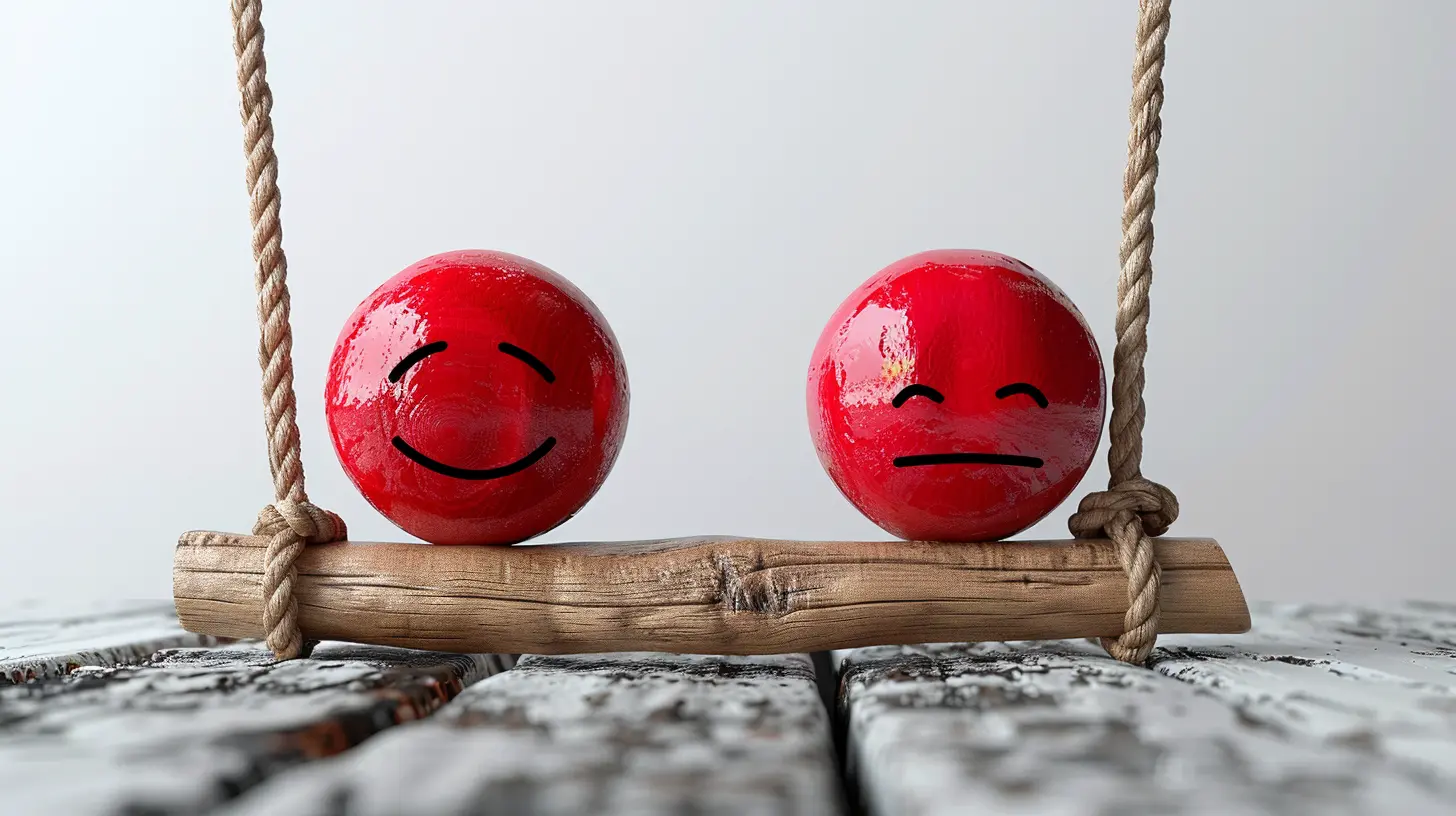Physical Exercise as a Tool for Emotional Balance
7 June 2025
When life gets overwhelming—and let’s be honest, it often does—many of us tend to look for quick escapes: binge-watching shows, comfort food, scrolling miles on social media. But what if I told you that one of the most effective tools for emotional well-being doesn’t come in a pill bottle or a digital screen… but rather in the form of something as simple as moving your body?
Yep, we’re talking about physical exercise—not just for six-packs or burning off pizza guilt, but as a profound and natural way to manage your emotions, calm your mind, and feel more balanced overall.
Let’s dig deep into how physical activity affects our emotional health and why it’s more powerful than most people realize.
Why Emotions Feel Like a Rollercoaster
Before we jump into the solution, let’s understand the problem. Why do our emotions feel so out of control sometimes?Emotions are not just "in your head". They’re the cocktail of hormones, brain chemicals, and physical sensations racing through your entire body. Stress, anxiety, sadness—they’re all responses driven by both your mind and your physical state. That’s why when you're anxious, your heart races. Or when you're sad, you feel exhausted.
So it makes perfect sense that if you want to feel better emotionally, a purely mental approach (like repeating "I’m fine" to yourself) often isn’t enough. You need to get your body involved.
Physical Exercise: The Mood Medicine You Didn’t Know You Needed
Think of exercise as your personal emotional thermostat. Regardless of whether you're dealing with low-grade anxiety, full-blown depression, or just feeling off, moving your body helps regulate your mental temperature. In fact, the impact is so real that psychologists often recommend exercise as part of treatment for mental health conditions.Let’s break down how it works.
1. Exercise Floods Your Brain With Happy Chemicals
Ever heard of endorphins?These are your body’s natural painkillers and mood lifters, and guess what triggers a flood of them? Yep—physical activity. But it’s more than just endorphins at play.
Here’s the happy cocktail your brain gets during and after exercise:
- Endorphins – Natural mood boosters
- Dopamine – The "reward" chemical tied to motivation and pleasure
- Serotonin – Known to reduce depression and anxiety
- Norepinephrine – Helps improve attention and focus
Think of it as your brain throwing a tiny party every time you go for a brisk walk, do a few yoga poses, or dance around your living room like nobody’s watching.
2. Movement Helps You Process Emotionally Heavy Stuff
Ever gone on a long walk after a heated argument or a bad day and somehow things feel clearer afterwards?That's not a coincidence.
Emotions are energy, and if you don’t move, that energy can get stuck. Exercise helps you "move through" emotions—literally and figuratively. It becomes a way of digesting emotional experiences. Movement provides just enough distraction and rhythm to allow your subconscious mind to do its job of sorting things out.
Running, cycling, swimming, lifting weights—whatever your flavor—can become an emotional detox session.
3. Physical Activity Lowers Your Stress Levels
When you're stressed, your body goes into fight-or-flight mode. That means cortisol—a stress hormone—pumps through your system. Too much cortisol over time can wreak havoc on your mood, your health, and even your sleep.Exercise acts like a reset button. When you move, your body burns off excess cortisol and signals the brain that you’re not in danger anymore.
It’s like telling your nervous system, “Hey buddy, it’s okay. We’re good.”
4. Exercise Improves Sleep (Which Boosts Emotional Balance)
Sleep and mental health go together like avocado and toast—one just isn't great without the other. Poor sleep can make irritability skyrocket, anxiety increase, and moods swing with no warning. But here’s the good news: regular exercise helps regulate your sleep cycles.By tiring out your body and releasing calming chemicals, exercise preps your brain for deeper, better-quality sleep. And better sleep equals more emotional stability, patience, resilience, and the ability to respond—not just react—to life.
5. It Builds Confidence and a Sense of Control
Feeling emotionally unbalanced often comes from feeling out of control. When everything feels chaotic, exercising can become your daily anchor—a small, consistent way to cultivate order, discipline, and accomplishment.Even if it’s just 15 minutes on a yoga mat or walking the dog around the block, that small choice reinforces the idea: “I may not be able to control everything, but I can control this.”
And that’s powerful.
6. Social Exercise Boosts Connection and Belonging
We’re wired for connection. And loneliness is one of the biggest contributors to emotional distress.Group fitness classes, sports teams, walking with a friend, or participating in a virtual challenge on a fitness app—all of these add a crucial sense of connection. You’re not just moving; you're bonding, laughing, encouraging one another, and feeling part of something bigger. Those are powerful mood boosters.
Small Movements, Big Benefits: You Don’t Have to Run Marathons
Let’s clear up a common myth: you don’t need to become a gym rat to see emotional benefits.Studies show that even moderate exercise—like walking briskly for 30 minutes five times a week—can significantly lift mood and reduce symptoms of depression and anxiety.
So don’t overthink it. Dance while you clean, take the stairs, do a couple of yoga stretches during TV commercials. What matters most is making movement a regular part of your life, not how intense or Instagram-worthy it is.
The Emotional Snowball Effect of Exercise
Once you start moving regularly, a beautiful thing happens—it builds momentum.You sleep better.
You're less snappy with loved ones.
You start to feel more motivated.
You make better food choices.
Your confidence grows.
Your resilience builds.
Each little action feeds the next. It’s like emotional compound interest. You're not just working out your body; you're training your brain, rewiring your emotional responses, and strengthening your mental muscles.
What Kind of Exercise Is Best for Emotional Balance?
Here’s the truth: the best kind of exercise is the one you will actually do. That said, different movements have slightly different emotional impacts:Cardio (e.g., running, cycling, brisk walking)
Great for stress relief and boosting those happy chemicals.Strength Training (e.g., weights, resistance bands, bodyweight)
Improves confidence, reduces anxiety, and helps you feel strong—inside and out.Yoga and Tai Chi
Ideal for calming the mind, reducing tension, and connecting breath with movement.Dancing
An incredible combo of cardio, creativity, and emotional expression. Plus, it’s fun!Group Classes or Sports
Add the benefit of social connection and shared experience.Tips to Get Started (Even If You’re Not "Into" Exercise)
Hey, not everyone loves the gym. That’s okay. Exercise doesn’t have to be about suffering or pushing through pain. It can be joyful, playful, and even something you look forward to.Here are some real-life tips to ease into it:
- Start small. Even 10 minutes counts. It builds the habit.
- Make it fun. Put on music. Try a dance video. Walk in nature.
- Build it into your routine. Attach it to something you already do, like brushing your teeth or morning coffee.
- Reward yourself. Not with cake—but with something meaningful, like a relaxing soak or favorite podcast.
- Track your wins. Even scribbling, “Walked 15 minutes today” on a sticky note feels good.
- Be kind to yourself. Every bit of movement matters. No guilt, no pressure.
When to Seek Professional Help (And Still Exercise)
Let's be clear here. Exercise is a powerful tool, but it’s not a cure-all. If you’re dealing with persistent depression, anxiety, trauma, or other mental health issues, professional support is essential. Exercise can play a supportive role, not replace therapy or medication when needed.In fact, combining physical activity with therapy often creates the best results. One supports the brain chemistry; the other helps you understand and reshape your thoughts and behaviors.
Final Thoughts: Move Your Body, Heal Your Mind
At the end of the day, we’re meant to move. Our ancestors didn’t sit at desks for 8 hours a day and then stare at screens for another 5. Our bodies evolved to move, and movement is deeply tied to how we feel emotionally.So next time you’re feeling overwhelmed, anxious, down, or stuck—try moving. Even a short, mindful walk can help shift your emotional state. Over time, regular movement becomes more than just a way to stay fit—it becomes your anchor, your therapy, your release, and your quiet reclaiming of emotional balance in a chaotic world.
And the best part? You don’t need to be perfect. You just need to begin.
all images in this post were generated using AI tools
Category:
Emotional RegulationAuthor:

Jenna Richardson
Discussion
rate this article
3 comments
Dusk Wyatt
Great article! It's amazing how a simple workout can boost our mood and help us find emotional balance. Exercise really is a powerful tool for mental well-being!
June 21, 2025 at 4:37 PM

Jenna Richardson
Thank you for your kind words! I'm glad you found it insightful—exercise truly is a game-changer for emotional health.
Flynn Wright
Exercise genuinely enhances emotional well-being; it’s a vital coping tool.
June 10, 2025 at 2:31 AM

Jenna Richardson
Thank you for your insightful comment! I completely agree—exercise not only improves physical health but also plays a crucial role in enhancing emotional well-being.
Sylas McLoughlin
Physical exercise isn't just a side note; it’s a fundamental pillar of emotional well-being. Sweating it out not only sculpts your body but also fortifies your mind. Dismissing exercise as merely a physical activity undermines its profound impact on mental health. Get moving—your emotions will thank you!
June 7, 2025 at 4:40 PM

Jenna Richardson
Absolutely! Exercise is crucial for both physical and emotional health. It's amazing how movement positively influences our mental well-being. Thank you for emphasizing its importance!



